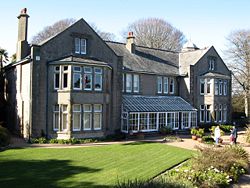
Overbeck's
Encyclopedia

Edwardian architecture
Edwardian architecture is the style popular when King Edward VII of the United Kingdom was in power; he reigned from 1901 to 1910, but the architecture style is generally considered to be indicative of the years 1901 to 1914....
house and 2.75 hectare (7 acre) garden
Garden
A garden is a planned space, usually outdoors, set aside for the display, cultivation, and enjoyment of plants and other forms of nature. The garden can incorporate both natural and man-made materials. The most common form today is known as a residential garden, but the term garden has...
situated in Sharpitor
Sharpitor
Sharpitor is a megalithic site near Lustleigh in Dartmoor, Devon, England. The tor is surrounded by forest, overlooking the Bovey Valley. The remains consist of a degraded but still visible stone row....
, Salcombe
Salcombe
Salcombe is a town in the South Hams district of Devon, south west England. The town is close to the mouth of the Kingsbridge Estuary, built mostly on the steep west side of the estuary and lies within the South Devon Area of Outstanding Natural Beauty...
, Devon
Devon
Devon is a large county in southwestern England. The county is sometimes referred to as Devonshire, although the term is rarely used inside the county itself as the county has never been officially "shired", it often indicates a traditional or historical context.The county shares borders with...
, England
England
England is a country that is part of the United Kingdom. It shares land borders with Scotland to the north and Wales to the west; the Irish Sea is to the north west, the Celtic Sea to the south west, with the North Sea to the east and the English Channel to the south separating it from continental...
. It is named after its last private owner Otto Christop Joseph Gerhardt Ludwig Overbeck (c.1852–1937). The house is now divided between museum and YHA youth hostel
Youth Hostels Association (England & Wales)
The Youth Hostels Association is a charitable organisation, registered with the Charity Commission, providing youth hostel accommodation in England and Wales...
.
The museum houses displays of some of Overbeck's inventions and collections of stuffed animals, and exhibitions of model sailing ships and various nautical and shipbuilding tools and effects. There are display photographs of boats and shipwrecks (such as the Herzogin Cecilie
Herzogin Cecilie
Herzogin Cecilie was a German four-mast barque , named after German Crown Princess Duchess Cecilie of Mecklenburg-Schwerin , spouse of Crown Prince Wilhelm of Prussia .- History :...
). A room in the middle of the house, one of whose entrances is a secret door concealed in the wooden panelling of the room outside, contains a display of dolls' houses, amongst which is placed by staff "Fred the friendly ghost" for child visitors to discover. The museum contains a "Polyphon" — a large musical box
Musical box
A music box is a 19th century automatic musical instrument that produces sounds by the use of a set of pins placed on a revolving cylinder or disc so as to pluck the tuned teeth of a steel comb. They were developed from musical snuff boxes of the 18th century and called carillons à musique...
which plays music encoded as holes punched in large sheet-metal discs. There is a collection of discs of popular melodies of the day which are played from time to time during the day when the museum is open. There is also a collection of photographs by Edward Chapman who worked in and photographed Salcombe — including the building of the first house on the site — during the early 20th Century. The photographs have been reprinted from the original plates by Chapman's son and his grandson, Chris Chapman, who continues the family photography business in Plymouth
Plymouth
Plymouth is a city and unitary authority area on the coast of Devon, England, about south-west of London. It is built between the mouths of the rivers Plym to the east and Tamar to the west, where they join Plymouth Sound...
.
History
The original building on the site was a small villa "Sharpitor" erected by Salcombe builder Albert StumblesStumbles (surname)
Stumbles is a family name probably originating in the United Kingdom but nowadays also found in Australia, South Africa, Zimbabwe, Canada, and the United States.- Origin :...
. This was bought in 1901 by Edric Hopkins, who also bought 2 acres (8,093.7 m²) more of land, creating terraces and planting exotic specimens on the sheltered site. In 1913 the property was bought by Mr and Mrs Vereker who demolished the original house and had the present one built. Otto Overbeck acquired the house in 1928 and lived there until his death in 1937. Wishing the house to be used after his death as "a public park and museum and a Hostel for Youth" Overbeck bequeathed it to the National Trust
National Trust for Places of Historic Interest or Natural Beauty
The National Trust for Places of Historic Interest or Natural Beauty, usually known as the National Trust, is a conservation organisation in England, Wales and Northern Ireland...
on condition it be used as such and not as a brothel as so many in the surrounding area became.

